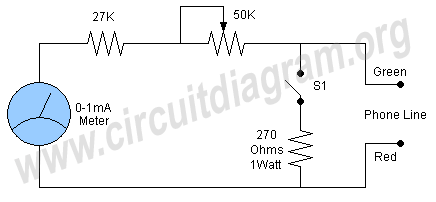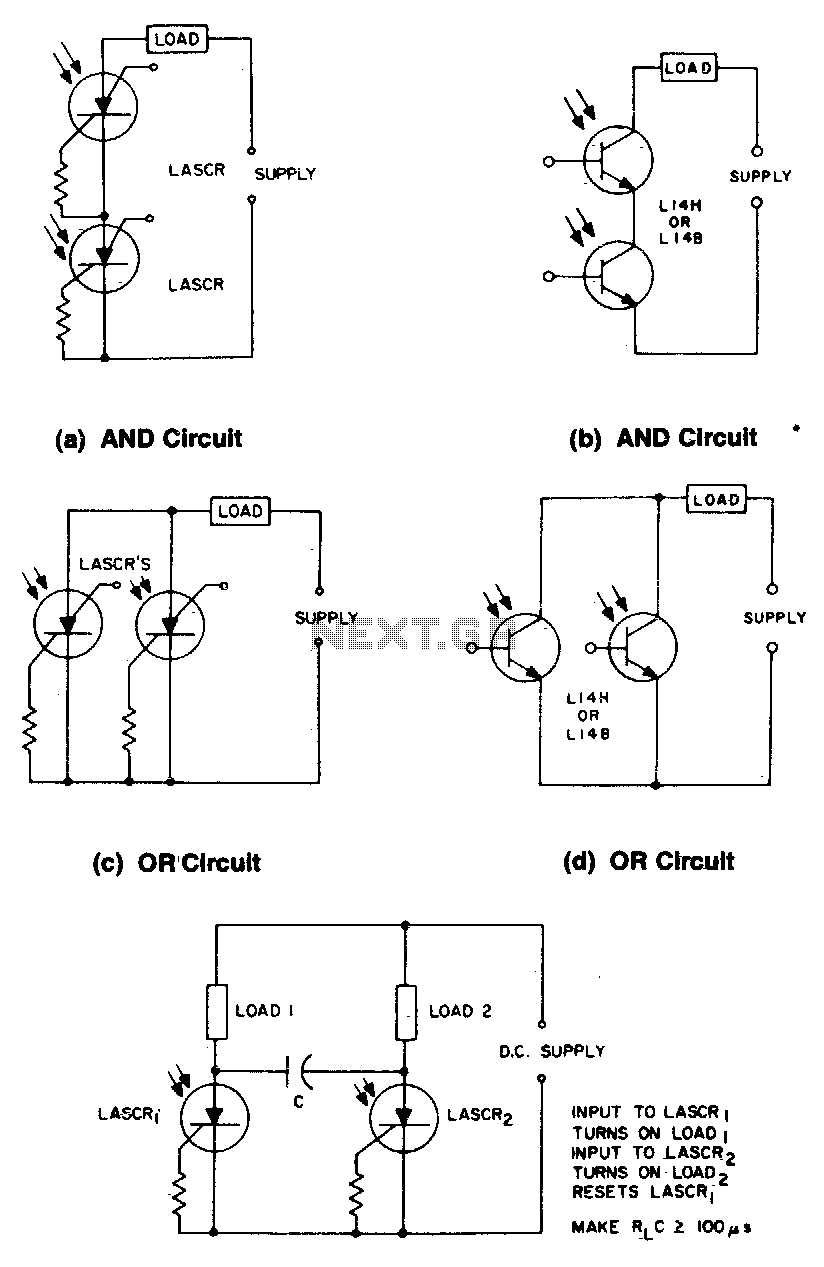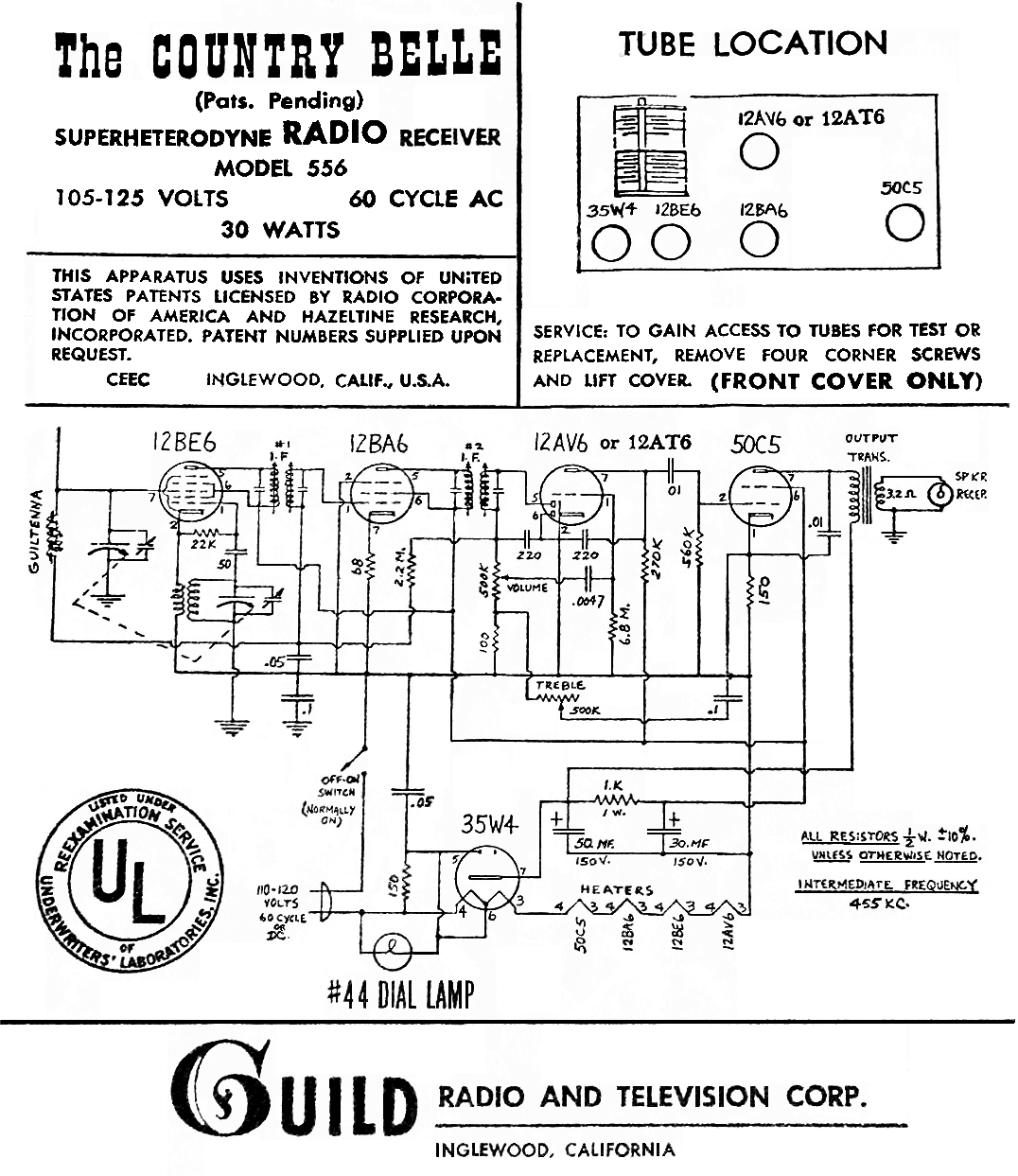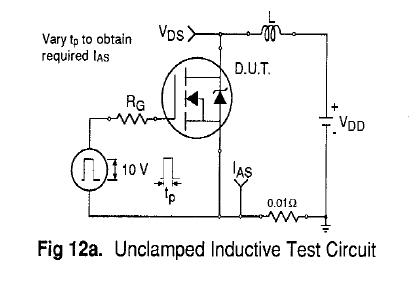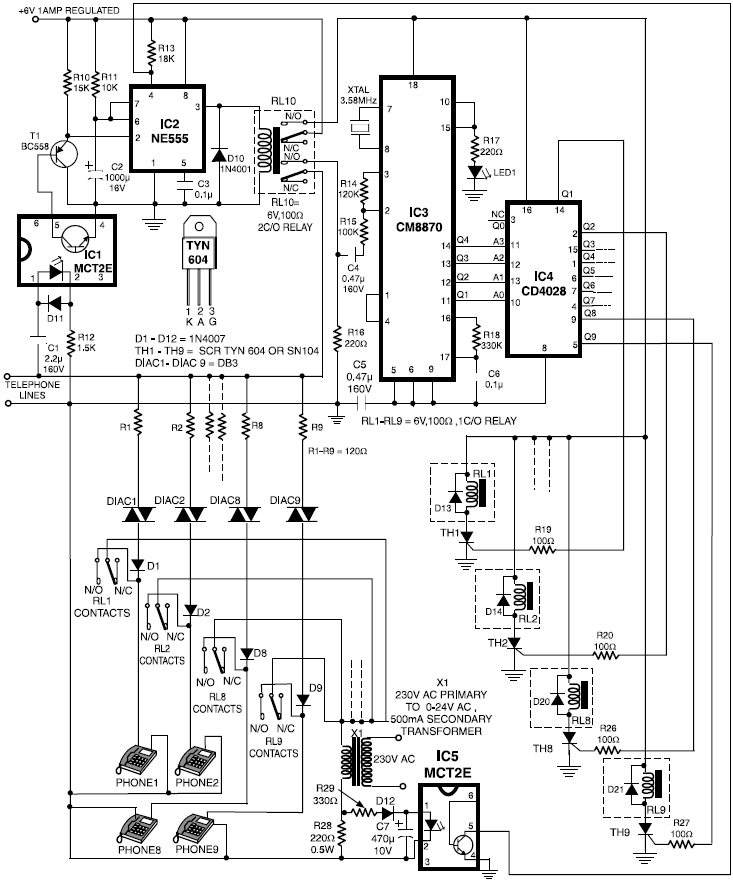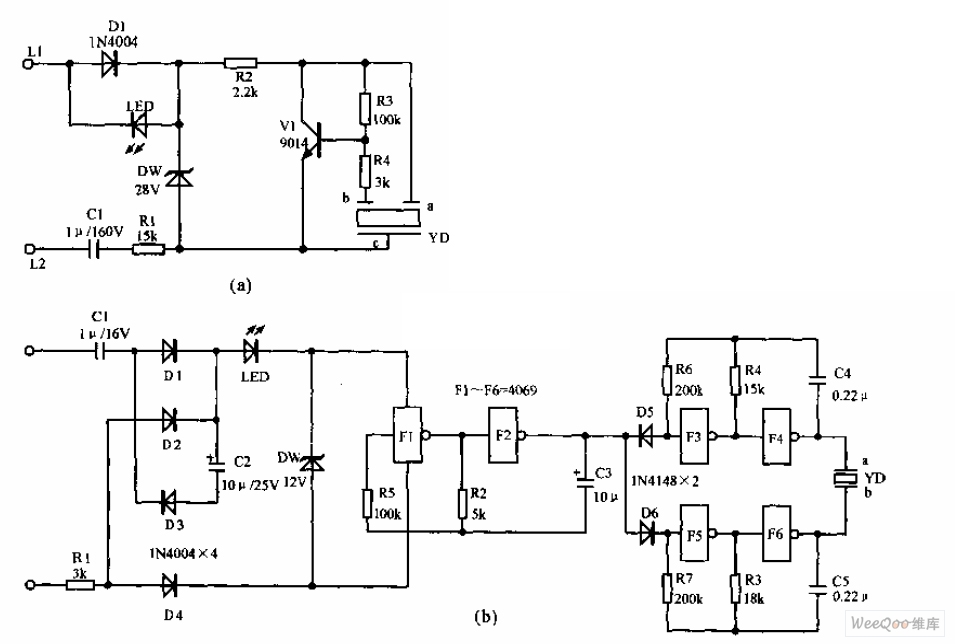
Telephone Circuits
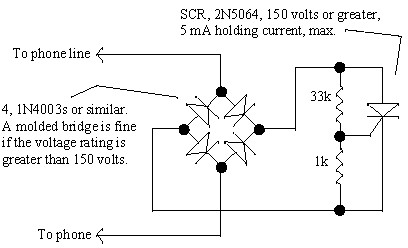
When a new computer modem is introduced into a home, the demand on the phone line increases significantly. Internet users can consume phone time similarly to a chatty teenager. Additionally, computer modem users often prioritize their privacy; for instance, picking up another receiver can disconnect them, resulting in frustration. The phone wiring can be modified so that the modem maintains control by connecting the phone line directly to the modem and linking other phones to the modem's "phone" jack. However, this approach grants excessive control to the computer user over the phone line and does not resolve the issue of two computers sharing a single line. A simple blinking LED circuit can be implemented to alert users when the line is in use before the receiver is picked up. This circuit lightly loads the phone line, complying with on-hook telephone equipment leakage specifications, and the brief lamp flashes draw minimal current from a nine-volt battery. Such devices can be placed at each extension without significantly burdening the phone line. The circuit connects to the red and green wires for a single-line system or the yellow and black wires for a two-line system. Polarity is not a concern due to the full-wave rectifier. To maintain phone line balance, the device should only be powered by a battery, as shown, and housed in a plastic case to insulate the battery and circuitry. Grounding the circuitry is not recommended. The circuit is compatible with various battery types and voltages; for example, four AA, C, or D cells (6 volts) will provide a longer lifespan for frequent users. A standard 9-volt rectangular battery is adequate for most applications. The diode bridge mitigates polarity issues; while it can be omitted, the phone line connections may need to be reversed if the circuit fails to operate correctly. The Phone Ringer circuit is functional with any standard phone, including older bell ringer models. It rings the phone in a realistic manner until answered, at which point the user hears a chosen audio clip. This could range from another telephone, a tape recording, a favorite talk radio segment, a fake busy signal, or any selected audio source. DC current is transmitted through the phone to activate its electronics. Features for experimentation include a ring inhibit control and an additional transistor that can activate devices upon answering the phone. The ring inhibit control initiates ringing when a signal goes low, while the activate-on-answer control can trigger a tape recording or another device when the phone is picked up. For instance, an alarm clock could activate the ringer to simulate a realistic wake-up call, with the user’s voice reminding them of the importance of getting up. This wake-up caller can be persistent, calling back immediately after hanging up. The phone cable consists of red and green wires connected to the designated points as indicated in the schematic, with polarity being non-critical. Additional devices may be connected as described, but no connection to an actual phone line is intended. The circuitry is straightforward and not highly sensitive. The first two inverters create a slow pulse generator controlling the ringing rate. Adjusting the 0.22 µF capacitor alters the ringing rate, while changing the series 22 Megohm resistor with the diode modifies the ring duration. The subsequent two inverters produce a 20 Hz ringing signal, which can be adjusted by changing the 0.033 µF capacitor. Mechanical bell ringers, which have a resonant clapper, should be driven at a frequency close to 20 Hz, although slight variations may enhance the ringing effect. The final two inverters buffer the ringing signal and drive the output.
The circuit design focuses on ensuring minimal interference with the phone line while providing a reliable alert system for users. The use of a battery power source minimizes the risk of affecting the phone line balance, which is crucial for maintaining proper functionality of connected devices. Additionally, the flexibility in audio output allows for customization, catering to various user preferences and situations. The implementation of inverters for generating the ringing signal demonstrates an efficient use of components to achieve the desired functionality without unnecessary complexity. Overall, this circuit serves as a practical solution for managing phone line usage in a household with multiple devices, enhancing user experience while maintaining privacy and control.When a new computer modem enters the household, the demands on the home phone line skyrockets. The Internet surfer can use phone time on a par with the most talkative teenager. And the computer modem user can be quite sensitive about his privacy: simply lifting another receiver can knock him off-line causing emotional stress. The phone wiring maybe modified so that the modem is always in control by connecting the phone line directly to the modem and connecting the rest of the phones to the modem`s "phone" jack. But this solution gives the computer user too much power over the phone line and it doesn`t solve the problem if two computers share a single line.
Here is a simple blinking LED circuit which will alert users when the line is in use before the receiver is lifted. The circuit loads the phone line so lightly that it meets the on-hook telephone equipment leakage specification and the short lamp flashes draw very little current from the nine-volt battery.
One of these devices may be placed at each extension without significantly loading the phone line. The circuit is connected to the red and green wires for a single-line system or the yellow and black wires for the second line in a two-line system. Polarity doesn`t matter, thanks to the full-wave rectifier. In order to preserve your phone line balance, do not power this device from a line-powered power supply.
Only use a battery as shown and insulate the battery and circuitry by building the device into a plastic case. Do not ground the circuitry. The circuit will work with other batteries and battery voltage. Four AA, C, or even D cells (6 volts) will last considerably longer if you have teenagers burning up your batteries.
A small 9-volt rectangular battery will be fine for most users. The diode bridge eliminates polarity concerns. It may be left out but the wires to the phone line may need to be reversed if the circuit doesn`t work properly. The Phone Ringer circuit will work with any ordinary phone including older bell ringer types. The circuit rings the phone in a completely realistic manner until someone answers. When the receiver is lifted the user hears the audio of your choice. It might be another telephone, a tape recording, a favorite talk radio show, a fake busy-signal, a scanner tuned to weather or police, cues for the actor who forgot his next line, or whatever audio source strikes your fancy.
DC current is passed through the phone to activate the phone ’s electronics. Provisions for experimenters include a ring inhibit control and an additional transistor will activate devices when the phone is answered. The ring inhibit control is used to start the ringing when a signal goes low and the activate-on-answer control can start a tape recording or other device when the phone is answered.
For example, the ringer could be triggered by an alarm clock to make an artificial but realistic wake-up call. When you answer, your own voice instructs you about the importance of getting up. This wake-up caller is quite persistent, calling back the instant you hang up! The phone cable will have red and green wires which are simply connected to the points indicated by the schematic.
Polarity should not matter. Other devices may be connected as described but no connection to a "real" phone line is intended. The circuitry is simple and not particularly critical. The first two inverters form a slow pulse generator which controls the ringing rate. Change the 0. 22 uf capacitor to change the ringing rate and change the 22 Meg. resistor in series with the diode to change the length of the ring. The second two inverters generate the 20 Hz ringing signal. This frequency can be changed by changing the. 033uf capacitor. Mechanical bell ringers have a resonant clapper and should be driven with a frequency near 20 Hz but a slight variation may give a better ring. The last two inverters buffer the ringing signal and drive the t 🔗 External reference
The circuit design focuses on ensuring minimal interference with the phone line while providing a reliable alert system for users. The use of a battery power source minimizes the risk of affecting the phone line balance, which is crucial for maintaining proper functionality of connected devices. Additionally, the flexibility in audio output allows for customization, catering to various user preferences and situations. The implementation of inverters for generating the ringing signal demonstrates an efficient use of components to achieve the desired functionality without unnecessary complexity. Overall, this circuit serves as a practical solution for managing phone line usage in a household with multiple devices, enhancing user experience while maintaining privacy and control.When a new computer modem enters the household, the demands on the home phone line skyrockets. The Internet surfer can use phone time on a par with the most talkative teenager. And the computer modem user can be quite sensitive about his privacy: simply lifting another receiver can knock him off-line causing emotional stress. The phone wiring maybe modified so that the modem is always in control by connecting the phone line directly to the modem and connecting the rest of the phones to the modem`s "phone" jack. But this solution gives the computer user too much power over the phone line and it doesn`t solve the problem if two computers share a single line.
Here is a simple blinking LED circuit which will alert users when the line is in use before the receiver is lifted. The circuit loads the phone line so lightly that it meets the on-hook telephone equipment leakage specification and the short lamp flashes draw very little current from the nine-volt battery.
One of these devices may be placed at each extension without significantly loading the phone line. The circuit is connected to the red and green wires for a single-line system or the yellow and black wires for the second line in a two-line system. Polarity doesn`t matter, thanks to the full-wave rectifier. In order to preserve your phone line balance, do not power this device from a line-powered power supply.
Only use a battery as shown and insulate the battery and circuitry by building the device into a plastic case. Do not ground the circuitry. The circuit will work with other batteries and battery voltage. Four AA, C, or even D cells (6 volts) will last considerably longer if you have teenagers burning up your batteries.
A small 9-volt rectangular battery will be fine for most users. The diode bridge eliminates polarity concerns. It may be left out but the wires to the phone line may need to be reversed if the circuit doesn`t work properly. The Phone Ringer circuit will work with any ordinary phone including older bell ringer types. The circuit rings the phone in a completely realistic manner until someone answers. When the receiver is lifted the user hears the audio of your choice. It might be another telephone, a tape recording, a favorite talk radio show, a fake busy-signal, a scanner tuned to weather or police, cues for the actor who forgot his next line, or whatever audio source strikes your fancy.
DC current is passed through the phone to activate the phone ’s electronics. Provisions for experimenters include a ring inhibit control and an additional transistor will activate devices when the phone is answered. The ring inhibit control is used to start the ringing when a signal goes low and the activate-on-answer control can start a tape recording or other device when the phone is answered.
For example, the ringer could be triggered by an alarm clock to make an artificial but realistic wake-up call. When you answer, your own voice instructs you about the importance of getting up. This wake-up caller is quite persistent, calling back the instant you hang up! The phone cable will have red and green wires which are simply connected to the points indicated by the schematic.
Polarity should not matter. Other devices may be connected as described but no connection to a "real" phone line is intended. The circuitry is simple and not particularly critical. The first two inverters form a slow pulse generator which controls the ringing rate. Change the 0. 22 uf capacitor to change the ringing rate and change the 22 Meg. resistor in series with the diode to change the length of the ring. The second two inverters generate the 20 Hz ringing signal. This frequency can be changed by changing the. 033uf capacitor. Mechanical bell ringers have a resonant clapper and should be driven with a frequency near 20 Hz but a slight variation may give a better ring. The last two inverters buffer the ringing signal and drive the t 🔗 External reference
